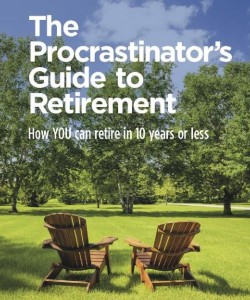 I have to hand it to financial author David Trahair. He and his publishers have come up with a catchy title that’s bound to sell a few copies of his latest (sixth) book. It’s titled The Procrastinator’s Guide to Retirement and sports an equally alluring subtitle: How YOU can retire in 10 years or less.
I have to hand it to financial author David Trahair. He and his publishers have come up with a catchy title that’s bound to sell a few copies of his latest (sixth) book. It’s titled The Procrastinator’s Guide to Retirement and sports an equally alluring subtitle: How YOU can retire in 10 years or less.
You can find a Q&A I conducted with Trahair about the book here at MoneySense.ca.
When I perused the book initially, my first impression was that there seemed to be relatively little about procrastination and the critical last ten years of Retirement. The book doesn’t have an index but my initial perception was that the book is a standard-issue retirement guide covering all the good things you should do throughout your working career, not just the final ten years.
Which came first, the book or the title?
I’ve been at book marketing sessions myself: that’s how a book originally titled Life After Mutual Funds morphed into The Wealthy Boomer. When the publishers at now defunct Key Porter Books heard me utter those words in response to who I thought the market was, I could see the dollar signs flashing behind their eyes.
However, in an interview with Trahair, he assured me that my cynical theory was incorrect, although “it’s interesting that you observed that.” It was targeted at procrastinators from the start, he said, including procrastinators like himself, now aged 57. He did concede however that the middle and later sections of the book are “more generic.”
There’s certainly a thorough presentation of retirement lore, most of which has appeared in other retirement guides, including Trahair’s five previously published books.
The good things procrastinators and in fact non procrastinators should do include of course cutting debt and diligently saving in RRSPs and TFSAs. Another is enrolling in the company pension plan if one is on offer. And there’s the usual summary of government retirement programs like CPP, OAS and the Guaranteed Income Supplement.
The truth is Canada is quite generous to true retirement procrastinators, and I know a few. If you save nothing and reach age 65, a senior couple that never worked a day or saved a penny could reap $30,000 a year solely from OAS and GIS, as retired actuary Malcolm Hamilton once equipped.
Trahair has been down this road before. The difference is that instead of writing for Wiley Canada, which has withdrawn from the Canadian publishing market, Trahair has published this book with Chartered Professional Accountants Canada. That makes some sense since Trahair is himself a CA, and a” cheap tightwad accountant” at that, he quips.
The book’s target market are those later in life who haven’t really started to save for retirement, even though it looms – as the subtitle says – just a decade away. That market constitutes a huge portion of the population, Trahair tells me.
Rather than berate them for their failure to save earlier, he empathizes with these legions of retirement procrastinators. “Life is so expensive,” he says, pointing to his own family: two kids, a mortgage, two cars for two working spouses, sending the kids off to university. “Of necessity, many become procrastinators.”
But he has a message of hope for these late-blooming would-be retirees. “There’s a lot you can do in ten years.” Mostly, Trahair is a fan of maxing out RRSP contributions for the retirement savings home stretch. Curiously, he’s not a big fan of TFSAs, although he concedes low-income procrastinators may be better off with TFSAs than RRSPs if they intend to live on nothing but OAS and GIS, or perhaps a bit of CPP.
However, that crowd probably doesn’t buy retirement books. Trahair believes anyone earning money in a higher tax bracket and who plans to retire in a lower bracket should focus on RRSPs.
Nor does he believe in taking much investment risk in those RRSPs. His previous book, Enough Bull!, famously preached in favor of RRSPs holding mostly GICs (Guaranteed Investment Certificates) and avoiding what Trahair sees as the inordinately high risk of stocks. (You can find my review of that book here at the Hub.) He does invoke the old rule of thumb that your fixed-income allocation should be roughly your age: so if you’re 60 years old, you would be 60% in cash or bonds and have a maximum 40% in stocks or equity funds.
Trahair has a fixation with debt that I share. I often write that the foundation of financial independence is a paid-for home and that would-be retirees have no business retiring if they still carry credit-card debt or even mortgage debt. Trahair largely agrees, and comes down primarily in favor of paying down the mortgage over investing more in an RRSP.
The cover of the book features not just one but two images of the most tired retirement cliché you can find: empty deck chairs just begging for a retired couple to plop down on them. Good on Trahair on improving the odds of that happening but if you want to do more than sit in a Muskoka chair, I still would recommend starting saving much earlier than the last ten years. The good news is that if there’s hope for procrastinators, there’s even more of it for those who start saving earlier in life.


